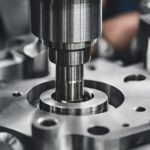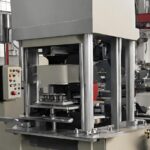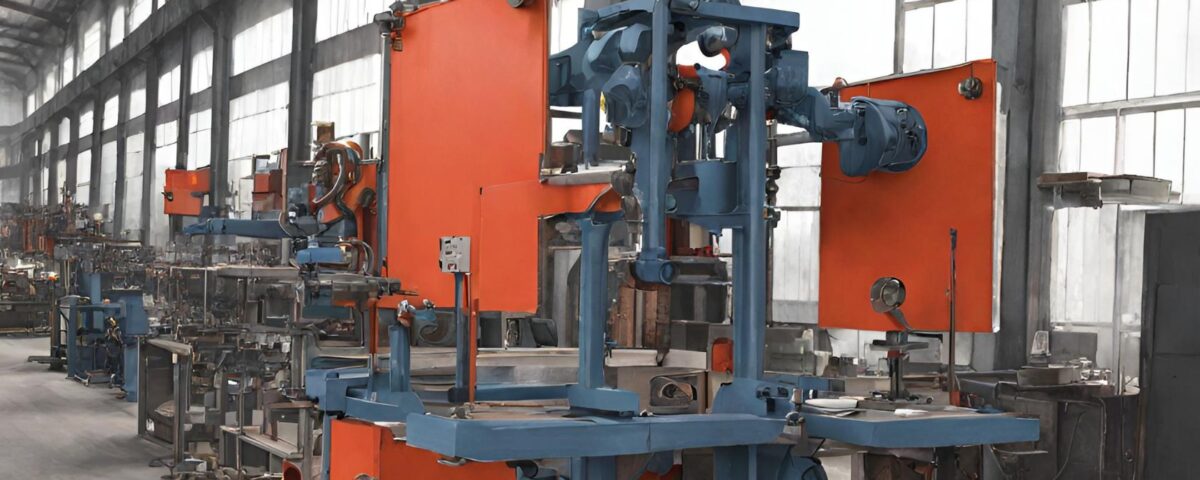
The Art of Precision Machining: Mastering Perfection in Every Cut
19 April 2024
How Aluminium Stamping Revolutionizes Manufacturing Processes
25 April 2024Are you fascinated by the art of aluminum casting and its ability to create stunning results? Look no further, as this article delves into the world of casting brilliance and how to master this intricate craft. Whether you're a professional or a hobbyist, understanding the techniques and processes involved in aluminum casting is essential for achieving exceptional results.
From the initial design and pattern creation to the melting and pouring of molten aluminum, every step in the casting process requires precision and knowledge. This article will guide you through the various methods of aluminum casting, from sand casting to investment casting, highlighting the unique advantages and considerations of each.
Discover the secrets of achieving flawless surface finishes, capturing intricate details, and ensuring structural integrity in your aluminum castings. Explore the importance of choosing the right alloy for your project and learn how to overcome common challenges in the casting process.
With expert insights and practical tips, this article is your go-to resource for mastering the art of aluminum casting and creating stunning pieces that will leave a lasting impression. Get ready to unleash your creativity and take your casting skills to the next level.
Advantages of Aluminum Casting
Aluminum casting offers numerous advantages that make it a popular choice for creating a wide range of objects and structures. Firstly, aluminum is a lightweight material, making it ideal for applications where weight is a concern. Despite its lightness, aluminum is also known for its strength and durability, making it suitable for a variety of industrial and artistic purposes.
Another advantage of aluminum casting is its excellent thermal conductivity. This property allows for efficient heat transfer during the casting process, ensuring that the molten aluminum fills the mold evenly and solidifies properly. Additionally, aluminum has a low melting point, which means it requires less energy and time to melt compared to other metals, making it a cost-effective choice.
Furthermore, aluminum is highly resistant to corrosion, making it an excellent choice for outdoor applications or objects exposed to harsh environments. It also has good electrical conductivity, making it suitable for electrical components and wiring. Lastly, aluminum is a highly recyclable material, making it an environmentally friendly choice for casting projects.

Types of Aluminum Casting Processes
There are several methods of aluminum casting, each with its own unique advantages and considerations. The choice of casting process depends on factors such as the complexity of the design, desired surface finish, and the quantity of castings required. Let's explore some of the most common types of aluminum casting processes:
- Sand Casting: Sand casting is the most widely used casting process and is suitable for producing large, complex, or custom-shaped aluminum castings. It involves creating a mold using a mixture of sand and a binder material. The mold is then filled with molten aluminum, which solidifies to form the desired shape. Sand casting allows for intricate details and is cost-effective for small to medium-scale production.
- Investment Casting: Also known as lost-wax casting, investment casting is a precision casting process that is ideal for producing highly detailed and intricate aluminum castings. It involves creating a wax model of the desired object, which is then coated in a ceramic shell. The shell is heated, causing the wax to melt and drain out, leaving a cavity. Molten aluminum is then poured into the cavity, creating an exact replica of the wax model. Investment casting produces high-quality, dimensionally accurate castings.
- Die Casting: Die casting is a versatile casting process suitable for high-volume production of complex and thin-walled aluminum castings. It involves injecting molten aluminum into a steel mold, also known as a die, under high pressure. The molten aluminum quickly solidifies, resulting in a precise and consistent casting. Die casting offers excellent dimensional accuracy and surface finish, making it suitable for a wide range of applications, including automotive and aerospace industries.
- Permanent Mold Casting: Permanent mold casting, also known as gravity die casting, is a process that utilizes reusable molds made from steel or iron. The molten aluminum is poured into the mold, and gravity fills the cavity. Once the aluminum solidifies, the mold is opened, and the casting is removed. Permanent mold casting offers better surface finish and dimensional accuracy compared to sand casting, making it suitable for medium-scale production.
Step-by-step Guide to Aluminum Casting
Precision machining is pivotal across various industries, each with unique requirements that dictate the use of specialized machining strategies and materials. Below is a table that outlines key industry applications, highlighting the specific needs and typical components produced via precision machining:
| Component | Description |
|---|---|
| Aluminum Alloys | Aluminum alloys are formulated by combining aluminum with other elements such as copper, silicon, magnesium, or zinc. The selection of the alloy depends on the specific requirements of the casting project, including desired properties such as strength, corrosion resistance, and heat resistance. Different alloys offer varying characteristics, so it's crucial to choose the appropriate one for the intended application. For example, 6061 aluminum alloy is known for its high strength and weldability, making it suitable for structural applications, while 356 aluminum alloy offers excellent fluidity and is commonly used in sand casting for intricate shapes. |
| Furnace | A furnace is a crucial component in the aluminum casting process, responsible for melting the aluminum alloy to its liquid state. Various types of furnaces can be utilized, including electric furnaces, gas-fired furnaces, or induction furnaces. The selection of furnace type depends on factors such as the scale of the casting project, energy efficiency requirements, and available infrastructure. Electric furnaces offer precise temperature control and are suitable for small to medium-scale operations, while gas-fired furnaces are preferred for larger-scale production due to their high melting capacity and cost-effectiveness. Induction furnaces use electromagnetic induction to generate heat within the metal, making them efficient and environmentally friendly options for melting aluminum alloys. |
| Crucible | A crucible serves as a container for holding the molten aluminum during the casting process. Crucibles are typically made of materials such as graphite or ceramics that can withstand the high temperatures required for aluminum casting. It is essential to choose a crucible that is compatible with aluminum and has sufficient capacity for the intended casting project. Crucible selection considerations include thermal conductivity, thermal shock resistance, chemical inertness, and durability. Proper care and maintenance of crucibles are necessary to ensure consistent casting quality and prolong their lifespan. |
| Molds | The choice of mold depends on the specific casting process being employed. Sand casting utilizes molds made from a mixture of sand and a binder material, such as clay or resin. These molds are relatively inexpensive and versatile, making them suitable for producing large and complex aluminum castings. Investment casting, also known as lost-wax casting, involves creating wax models that are coated with ceramic shells to form the molds. This process is ideal for producing intricate and dimensionally accurate aluminum parts with fine surface details. Die casting and permanent mold casting employ steel or iron molds, which offer high durability and dimensional stability for mass production of aluminum components with tight tolerances. Regardless of the casting method, it is essential to ensure that the molds are properly prepared and free from defects or imperfections that could compromise the quality of the final casting. |
| Finishing Tools | After the casting process is complete, various tools may be required to refine and finish the surface of the aluminum casting. These tools include files, sandpaper, grinding wheels, polishing compounds, and other abrasives. The choice of finishing tools depends on factors such as the desired surface finish, level of detail required, and material properties of the casting. For instance, coarse abrasives like files and grinding wheels are used for removing excess material and shaping the casting, while finer abrasives such as sandpaper and polishing compounds are employed to achieve a smooth and polished surface finish. Finishing operations are essential for enhancing the aesthetic appeal, functionality, and performance of aluminum castings, as well as ensuring dimensional accuracy and surface integrity. Proper handling and use of finishing tools are necessary to achieve consistent results and maintain the quality of the cast components. |

Common Challenges in Aluminum Casting and How to Overcome Them
While aluminum casting offers many advantages, there are also some common challenges that casters may encounter. Understanding these challenges and knowing how to overcome them is crucial for achieving high-quality castings. Here are a few common challenges and their solutions:
Shrinkage and porosity are common challenges encountered during the solidification process of aluminum casting. Minimizing shrinkage requires careful mold design, incorporating adequate risers and feeders to ensure a continuous supply of molten metal and prevent void formation. Porosity reduction involves implementing effective gating and venting systems, alongside controlling the cooling rate to prevent gas entrapment within the casting.
Surface finish plays a crucial role in the quality of aluminum castings. Achieving a smooth surface demands meticulous mold preparation with high-quality sand or ceramic materials. Post-casting finishing techniques like sanding, polishing, or shot blasting can further refine the surface texture, enhancing the appearance and functionality of the casting. Cracking poses a significant risk, typically due to thermal stresses or improper cooling. Preventive measures include proper preheating of molds and castings to minimize thermal gradients, controlling cooling rates, and employing post-casting heat treatments to relieve residual stresses. Ensuring dimensional accuracy entails careful pattern design, incorporating features like draft angles and shrinkage allowances, coupled with regular equipment calibration and maintenance to mitigate variations and ensure precise final dimensions.
Safety Precautions for Aluminum Casting
Safety should always be a top priority when engaging in aluminum casting. Here are some essential safety precautions to follow:
When engaging in aluminum casting, prioritizing safety measures is paramount. Begin by donning appropriate protective gear such as heat-resistant gloves, safety glasses, and a face shield to shield against molten metal splashes and harmful fumes. Conduct casting activities in well-ventilated areas to prevent the buildup of toxic fumes. If indoors, ensure effective ventilation systems or utilize exhaust fans to swiftly dispel any fumes, safeguarding against respiratory hazards.
Furthermore, proactive fire safety precautions are essential due to the high temperatures involved in aluminum casting. Keep a readily accessible fire extinguisher nearby and meticulously maintain a workspace devoid of flammable materials to mitigate fire risks. Equally critical is the proper handling and maintenance of casting equipment, including furnaces and crucibles. Regular inspections ensure equipment functionality, reducing the likelihood of accidents or malfunctions during the casting process.
Lastly, prioritize acquiring comprehensive training and knowledge in aluminum casting techniques and safety protocols before undertaking any casting endeavors. Familiarize yourself with the specific risks associated with your chosen casting method, empowering yourself to mitigate potential hazards effectively. By adhering to these safety guidelines and investing in thorough preparation, you can execute aluminum casting projects with confidence and security.
Finishing Techniques for Aluminum Castings
The beauty of aluminum castings can be further enhanced through various finishing techniques. Here are some common techniques used to achieve different surface finishes:
Polishing aluminum castings involves utilizing abrasives like sandpaper, polishing compounds, or buffing wheels to refine the surface, resulting in a high-gloss or mirror-like finish. This technique enhances the appearance of the casting, providing a sleek and professional look that is visually appealing. Additionally, shot blasting offers an alternative method for surface refinement by propelling small metal or ceramic particles at high speed onto the casting. This process effectively removes surface imperfections such as burrs or rough spots, resulting in a textured or matte finish that not only improves aesthetics but also enhances the casting's overall quality and durability. Anodizing presents another option, employing an electrochemical process to form a protective oxide layer on the surface of the aluminum casting. This not only enhances appearance but also boosts corrosion resistance, offering versatility in color customization to suit specific design preferences. Finally, painting or powder coating can be applied to aluminum castings for color or texture customization, providing additional protection against corrosion while adding aesthetic appeal to the casting's surface.
Conclusion
Unlock the full potential of aluminum casting by delving into its intricacies – from processes to materials and equipment. Embrace safety measures, conquer challenges, and delve into diverse finishing techniques to elevate your aluminum casting endeavors. With dedication and practice, you can hone your skills and craft aluminum pieces that captivate and endure.
Embark on your journey to mastery today. Let your creativity soar, push boundaries, and let the brilliance of aluminum casting illuminate your creations. With each project, you inch closer to becoming a true artisan in the realm of aluminum casting. Let's cast brilliance together! Contact us right now.




